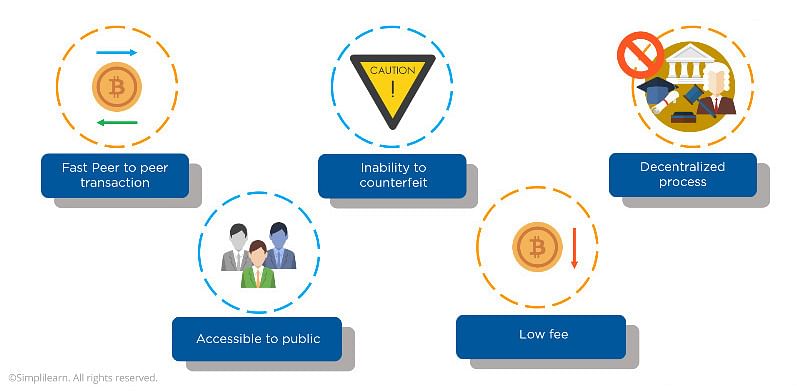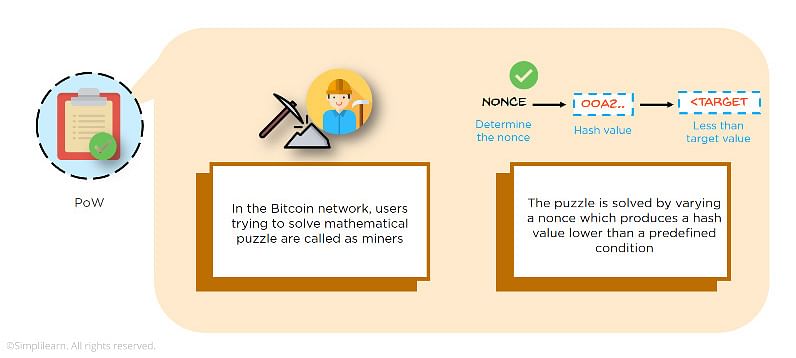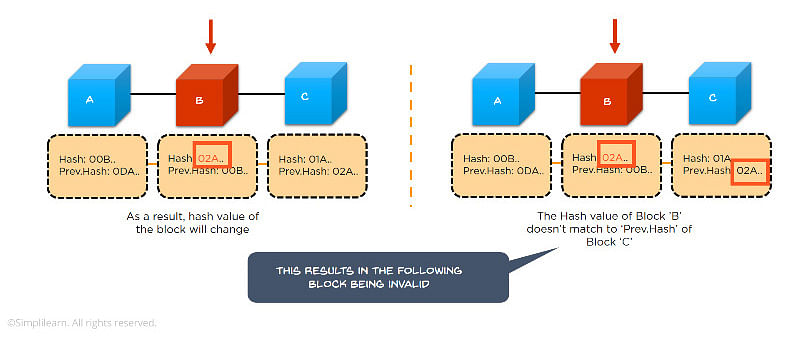What is Bitcoin Mining?
By Shivam Arora
Last updated on Nov 18, 202253325281

Table of Contents
View More
As of late March 2022, Bitcoin value hit clocked in at $43,394.80 on the exchange market. This value is an indication of good tidings for the cryptocurrency. Over the years, there has been such a growing interest in the Bitcoin currency that its value has grown to resemble that of gold.
The future is promising for Bitcoin miners and enthusiasts, and it’s a potentially rewarding enterprise for anyone who wants to give it a go. However, let’s first take some time to learn the basics about Bitcoin mining.
In brief
- The blockchain ledger keeps growing as transactions that have taken place in the network are constantly added to it.
- Transactions in the blockchain network are grouped into blocks that are linked together to form a chain of blocks, hence blockchain.
- Blockchain transactions are stored in chronological order marked by timestamps and hash functions.
- By this virtue, records stored in the blockchain network are permanent and immutable.
Learn From the Best IIT Kanpur Faculty!
Professional Certificate Program in BlockchainEXPLORE PROGRAM

There are three ways through which bitcoin miners can acquire bitcoins. These are:
- Purchasing bitcoins on the exchange market
- Accepting bitcoin in exchange for goods and services
- Mining new bitcoins
Of these three, bitcoin mining is perhaps the most exciting option as it sends miners on a path to discovery. There is a caveat. Bitcoin mining can be quite taxing as it requires very high computing power to solve complex mathematical equations to verify transactions and add them to the blockchain digital ledger.
Simplilearn’s video tutorial explains the process of Bitcoin mining and the advantages of Bitcoin over traditional fiat currencies.
What Is Bitcoin Mining?
Bitcoin mining refers to ensuring that transactions are valid and added to the Bitcoin blockchain correctly using a global network of computers running the Bitcoin code. The process of mining is also the means by which new Bitcoins are created.
- The process of bitcoin mining involves the verification of new transactions against the Bitcoin network, which results in the production of new bitcoins.
- Bitcoin mining is the process by which Bitcoin transactions are validated digitally on the Bitcoin network and added to the blockchain ledger.
- It is done by solving complex cryptographic hash puzzles to verify blocks of transactions that are updated on the decentralized blockchain ledger.
Solving these puzzles requires powerful computing power and sophisticated equipment. In return, miners are rewarded with Bitcoin, which is then released into circulation hence the name Bitcoin mining.
Also Read: Blockchain Tutorial for Beginners to Advanced Level
What Is Crypto Mining?
Cryptocurrency mining is a process of creating new digital “coins.” However, that is as far as simplicity goes. The process of recovering these coins requires solving complex puzzles, validating cryptocurrency transactions on a blockchain network and adding them to a distributed ledger to locate them.
What Is Bitcoin?
Bitcoin is the first decentralized digital currency that allows peer-to-peer transfers without any intermediaries such as banks, governments, agents, or brokers, using the underlying technology of blockchain. Anyone around the world on the network can transfer Bitcoins to someone else on the network regardless of geographic location; you just need to just open an account on the Bitcoin network and have some Bitcoins in it, and then you can transfer those Bitcoins. How do you get Bitcoins in your account? You can either purchase them online or mine them.
Bitcoin can be used for online purchases and or as an investment instrument. Primarily it’s used to buy goods and services.
Bitcoin Advantages
Compared to traditional fiat currencies, assets can be transferred faster on the bitcoin network. The system also has lower transaction fees, because it’s decentralized and there are no intermediaries, and it is cryptographically secure—the identities of the sender and the receiver are kept hidden, and it is impossible to counterfeit or hack the transactions. Plus, all the information is available on a public ledger, so anyone can view the transactions.

What Is Blockchain?
As mentioned, blockchain is the underlying technology of bitcoin. Blockchain is a public distributed ledger in which transactions are recorded in chronological order. Any record or transaction added to the blockchain cannot be modified or altered, meaning transactions are safe from hacking. A block is the smallest unit of a blockchain, and it is a container that holds all the transaction details. A block has four fields, or primary attributes:
- Previous hash: This attribute stores the value of the hash of the previous block, and that’s how the blocks are linked to one another.
- Data: This is the aggregated set of transactions included in this block—the set of transactions that were mined and validated and included in the block.
- Nonce: In a “proof of work” consensus algorithm, which bitcoin uses, the nonce is a random value used to vary the output of the hash value. Every block is supposed to generate a hash value, and the nonce is the parameter that is used to generate that hash value. The proof of work is the process of transaction verification done in blockchain.
- Hash: This is the value obtained by passing the previous hash value, the data and the nonce through the SHA-256 algorithm; it is the digital signature of the block.
SHA-256 is a cryptographic hash algorithm that produces a unique 256-bit alphanumeric hash value for any given input, and that is the unique feature of this cryptographic algorithm: Whatever input you give, it will always produce a 256-bit hash.

3 Concepts of Blockchain
To understand bitcoin mining, you have to first understand the three major concepts of blockchain.
- Public distributed ledger: A distributed ledger is a record of all transactions maintained in the blockchain network across the globe. In the network, the validation of transactions is done by bitcoin users.
- SHA-256: Blockchain prevents unauthorized access by using a hash function called SHA-256 to ensure that the blocks are kept secure. They are digitally signed. Their hash value, once generated, cannot be altered. SHA-256 takes an input string of any size and returns a fixed 256-bit output, and it is a one-way function—you cannot derive the reverse of the input reverse fully from the output (what you have generated).
- Proof of work: In blockchain mining, miners validate transactions by solving a difficult mathematical puzzle called proof of work. To do that, the primary objective of the miner is to determine the nonce value, and that nonce value is the mathematical puzzle that miners are required to solve to generate a hash that is less than the target defined by the network for a particular block.

Bitcoin Profit and Bitcoin Mining Profitability
Bitcoin Profit is an automated crypto robot that helps trade Bitcoins and other cryptocurrencies to earn profit. It uses an AI algorithm to identify trading opportunities in the crypto market that can automatically close and open your trade, saving your time and manual intervention during trading. It claims that around 85% of its trades produce profits in normal market conditions. However, technical knowledge is required to calculate the profit generated through the Bitcoin mining process.
Talking about the actual Bitcoin profit – the real money making – it depends upon the cost of the AISC hardware, electricity consumption, and the effectiveness of the mining software. Bitcoin Mining profitability has decreased in recent times compared to the previous years because of the rise in electricity costs, costlier hardware, difficulty in mining due to an increase in competition, and a decrease in the Bitcoin prices. Earlier, Bitcoin Mining was initiated using CPUs and easy AI Algorithms, making it profitable and less costly.
Learn Through Industry-relevant Projects!
Caltech Blockchain BootcampEXPLORE PROGRAM

Bitcoin vs. Traditional Currencies
While both Bitcoin and traditional currency are similar in that both are a store of value, they differ in many ways. First things first, Bitcoin is the first and most recognized cryptocurrency – a digital currency that is secured by cryptography. Traditional currency, also referred to as fiat money, is a government-issued and regulated currency.
Some differences between Bitcoin and traditional currencies are illustrated in the table below.
| Bitcoin | Traditional Currency | |
| Tangibility | It is a virtual currency and can only be used in its digital form | It is a physical currency in the form of notes and coins. However, we can use it in both physical and digital forms |
| Regulation | Issued through mining and controlled by a decentralized distributed network of computers | Issued and controlled by central government authorities, i.e., central banks. Owing to this, the traditional currency is the legal tender in the country governed by the issuing authority. |
| Governance | Governed by a consensus mechanism in which the majority rules | Purely governed by the central bank |
| Value | Value is backed by the trust of its users. The more users are willing to transact with Bitcoin, the more stable it becomes. | Value is determined by forces of supply and demand and is thus vulnerable to inflation |
| Supply | Capped at 21 million bitcoin | Fiat currency has no supply limit |
| Validation of transactions | Bitcoin transactions are validated using blockchain technology and so do not require an intermediary for validation | Transactions involve an intermediary such as a bank or a payment provider |
| Transaction fees | Minimal or no associated fees as intermediaries have been eliminated | Transactions attract considerable charges |
| Transaction time and speed | The transaction is almost always instantaneous or greatly depends on the network speed | Transactions may take time before verification or before they reflect on the system |
| Security | The concepts of decentralization, cryptography, and consensus guarantee a secure network and security of bitcoin transactions | Less secure as it can be negatively affected by fluctuations in government policies |
| Reversals | Bitcoin transactions cannot be charged back, reversed, or canceled | Chargebacks, reversals, and cancellations are commonplace with traditional currency transactions |
How Does Bitcoin Mining Work: Public Distributed Network, POW, The 64-Digit Hexadecimal Number (SHA-256 Algorithm)
Blockchain is a decentralized peer-to-peer network that has been hailed as highly secure and transparent, hence trustworthy. This is because records in the blockchain network are secured using timestamps and cryptographic hash functions in such a way that after being added to the ledger, it is almost impossible and impractical to alter the transactions. At the core of blockchain security is the absence of centralized control.
Here is a breakdown of what happens during bitcoin mining
- The Mining Requirements
A bitcoin miner will first select their tools of the trade and set them up. These include:
- Hardware GPU (graphics processing unit), SSD for crypto mining, or ASIC (application-specific integrated circuit)
- Mining software
- A wallet
- Preferred mining pool (if one chooses pool mining option instead of solo mining)
Once all these are set up and the system fired up, it performs the mining process autonomously. Any other human involvement comes in the event of system or network failure, power outage, or regular system maintenance.
- Elements of a Bitcoin Transaction
When a transaction is initiated in the bitcoin network, three elements are involved:
- A transaction input
- A transaction output
- The transaction amount
For every transaction input, a bitcoin mining software generates a unique cryptographic hash puzzle that is difficult to decode. The software then groups the number of transactions required to form a block into a Merkle tree.
- The Merkle Tree and the SHA-256 Algorithm
A Merkle tree is a data structure of the hashes in a block and acts as a summary of all the transactions in the block. In the Merkle tree, hashes of individual transactions known as transaction IDs are paired repeatedly using the SHA-256 algorithm until only one hash identifies the entire tree. This hash is known as the Merkle root or root hash.
The Merkle tree enables the efficient verification of transactions in the bitcoin network.
- The Block Header
The Merkle root, the identifier of a Merkle tree, is stored in the block header. The block header contains information about the block and includes the following components:
- The version number of the bitcoin software
- The hash of the previous block
- The Merkle root (root hash)
- Timestamp
- Cryptographic nonce
- The target
This is the information miners will use to solve the hash puzzle and add a block transaction.
- Solving the Hash Puzzle
Miners must solve the hash puzzle by finding the hash below a given target through the difficulty requirement. The target, stored in the header, is expressed as a 67-digit number that will determine the mining difficulty based on the number of miners competing to solve a hash function. It is important to note that this difficulty adjusts after every 2016 blocks are created depending on how much time it took miners in the previous 2016 blocks to solve an equation. This also helps to maintain the rate at which transactions are appended in the blockchain at 10 minutes.
To solve the hash puzzle, miners will try to calculate the hash of a block by adding a nonce to the block header repeatedly until the hash value yielded is less than the target. Once a mining computer solves the puzzle, a new block is successfully created that is validated in the Bitcoin network after a consensus between the nodes has been reached. When a block is validated, the transactions bundled in it are verified and the block is added to the chain. As indicated above, this happens every 10 minutes.
As there will be many miners (systems) competing to solve the puzzle, the first miner to get the correct hash value earns a reward in Bitcoin. This process allows more Bitcoins in circulation.
Mining and Bitcoin Circulation
Bitcoin’s upper supply limit of 21 million bitcoin set by its source code by Satoshi Nakamoto, its inventor, is puzzling. However, experts have seen it as a huge advantage because the scarcity of supply breeds value and a stable price for the oldest crypto.
From the genesis Bitcoin block mined in 2009 with 50 bitcoins, more bitcoins have since been mined and released into circulation. Bitcoin mining ensures that blocks of transactions are created and stacked in the right order in a way that can be traced and proven mathematically. With the creation of blocks comes bitcoins as a reward, which increases the number of bitcoins in circulation.
Bitcoin architecture was structured ingeniously such that every 10 minutes, a block is discovered, and a fixed bitcoin award is offered for every block that is mined.
Prevention of Hacking
What if someone tries to hack the data? Blockchain, as the name implies, is a chain of blocks—let’s call the blocks A, B and C. Each block has solved a puzzle and generated a hash value of its own, which is its identifier. Now suppose a person tries to tamper with block B and change the data. The data is aggregated in the block, so if the data of the block changes, then the hash value that is the digital signature of the block will also change. It will therefore corrupt the chain after it—the blocks ahead of block B will all get delinked, because the previous hash value of block C will not remain valid.
For a hacker to make the entire blockchain valid for the block B that has been changed, he or she would have to change the hash value of all the blocks ahead of block B. This would require a huge amount of computing power and is next to impossible. With this method, blockchain is non-hackable and prevents data modification.

Why Mine Bitcoin?
Let’s be straight: people primarily mine Bitcoin to earn profits. Other than that, people who are curious about this technology and how it works enjoy experimenting with this relatively new technology.
How to Mine Bitcoin?
The Bitcoin miners are suggested to use mining hardware, such as Ebang, Antminer, Minedollars, AvalonMiner, or more that generates new Bitcoins after every 10 minutes. To mine Bitcoin, the miner is advised to invest in a powerful setup designed specifically for mining cryptos. Excessive or advanced computer knowledge must be possessed to operate the hardware system. The user then has to create at least one Bitcoin wallet for Bitcoin Mining that is secured and convenient.
Once the mining hardware is set up and the Bitcoin wallet is created, the miner must adopt strategies to install and configure the mining software. The miner has to apply technical knowledge to improve the mining capacity. The mining process then begins after the miner downloads a soft copy of the blockchain of Bitcoin and clicks on the start button. The miner needs to monitor the progress regularly to ensure that the mining application runs smoothly. However, the miner does not need to do anything manually and can rely on the mining hardware after the mining process is started. Because of the Bitcoin Mining process, new blocks are added to the blockchain.
Also Read: 10 Things You Didn’t Know About Bitcoin
How to Mine Bitcoin at Home?
Mining Bitcoins at home is challenging and requires certain steps to achieve good results. The first step is to set up the hardware properly and search for a strong power connection. The person then can create a mining wallet in any trading platform of their choice and join a mining pool to proceed further. The most important step is installing an effective mining software such as Awesome Miner, Easy Miner, and Pionex and then inserting the wallet details and the information about the mining pool.
However, the hardware needed for mining is expensive, and everyone cannot afford it. Moreover, mining Bitcoins requires a lot of electricity consumption. Only people who have access to low-cost electricity can afford to mine Bitcoins at home. Therefore, Bitcoin Mining at home can be profitable but needs resources and efforts whose costs are huge.
How to Calculate Bitcoin profit?
Keeping aside the actual Bitcoin profit earned by mining, miners have to perform a cost-benefit analysis to understand their break-even price before purchasing costly hardware or other mining equipment.
To calculate the Bitcoin profit, one must analyze the amount spent purchasing Bitcoin currencies. The next step is to check how much 1 Bitcoin costs at the purchase and compare it with the current value. The differences between the current and old values will provide a clear idea about the amount of profit earned.
Several factors that hinder Bitcoin’s profit are:
Cost of Power
The price of electricity changes every season. Electricity is consumed not only to mine Bitcoins but also to prevent them from overheating and cooling them down.
Time
There is no time length for mining. Many miners mine 24×7 as they can afford the mining cost.
Bitcoin value
Changes in the Bitcoin value are ascertainable, affecting your Bitcoin profit and return on investment.
Efficiency
Difficulty in mining can arise due to slow computers, low voltage, or any other factor, affecting efficiency.

FREE Crypto Mining Course?!
Learning Everything about how to safely buy bitcoin, how to invest it, and how to secure your transactions for instant cash out deposits
You feel safe knowing that this bitcoin course insures your data privacy!
Easy to follow, and it teaches you everything about bitcoin mining and crypto-currency.
Get Started For FREE Below
course closing soon!
